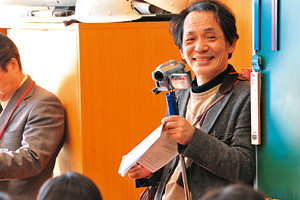Some of the News Fit to Print
ABOUT HIGHER ED
‘COLBERT REPORT’ EXPLAINS MOOCS
Anant Agarwal, president of edX, one of the major providers of massive open online courses, appeared on "The Colbert Report" this week, where he faced some questions on MOOCs that journalists had previously failed to ask him, at least not the Stephen Colbert way. After Agarwal explained the basic concept of MOOCs, Colbert asked if he was talking about the University of Phoenix. After Agarwal explained that MOOCs are free, Colbert said that if he owned a shoe store, and Agarwal was an employee and suggested giving away shoes for free, "I would fire you and throw shoes at your head." The information and a link to the video is at Inside Higher Ed.
SHIRKY SAYS MOOCS MATTER
Clay Shirky, a best-selling author and an associate arts professor at New York University’s Interactive Telecommunications Program, is known for predicting how the latest tech trends will change traditional social institutions. These days he’s turning his focus to colleges themselves, imagining ways that MOOCs and other technologies might reshape higher education. “For as long as students and their parents have nervously scanned tuition bills, they’ve asked themselves, ‘Isn’t there another way to do this?’” he wrote in a recent essay on The Chronicle of Higher Education's Web site. “And for that long, the answer has been ‘no.’ Now, for the first time, the answer is ‘maybe.’”
ABOUT K-12
WEINGARTEN CALLS ON TEACHERS TO IMPROVE
Speaking in front of the American Federation of Teachers rank and file earlier this week, Randi Weingarten didn’t mince words. The AFT president said that it was the responsibility of all those present to do everything they can to remove unskilled teachers from schools. Not only do bad teachers cast the profession in a bad light, they actively harm students who rely on them for knowledge and improvement. By adopting this tougher stance, Weingarten echoes talk around a number of state houses all over the country. Almost every state in America has over the past 10 years experimented with — or at least debated — teacher evaluation systems that would make it easier to separate effective instructors from ineffective ones. The article is in EducationNews.org.
WHEN STUDENTS ARE UNPREPARED
Jessica Pliska of the Opportunity Network writes in the Huffington Post: Too often students are derailed by everyday problems they are unprepared to handle. Even the highest achieving low-income students become overwhelmed and overstressed when they find themselves in situations that are dramatically different from any they have seen before. If we want more students to not only get to college but through college, education policymakers must look beyond the traditional targets of standardized test scores and financial aid to incorporate basic skills and college success into high school curricula.
posted Jul 26, 2013 10:02 am
ABOUT HIGHER ED
‘SHAKE UP’ FOR HIGHER ED
President Obama vowed Wednesday that he would soon unveil a plan to promote significant reform in higher education -- with an emphasis on controlling what colleges charge students and families. "[I]n the coming months, I will lay out an aggressive strategy to shake up the system, tackle rising costs, and improve value for middle-class students and their families. It is critical that we make sure that college is affordable for every single American who’s willing to work for it," said Obama, in a speech at Knox College. The article is in Inside Higher Ed.
STATES REFORM COLLEGE REMEDIAL EDUCATION
About 60 percent of community college students enroll in at least one developmental education course, according to the Community College Research Center at Columbia University’s Teachers College. At four-year colleges, about 20 percent of freshman students enroll in remedial classes, according to Complete College America, a nonprofit in Washington, D.C., which has led efforts to reform remedial education. One study estimated the annual cost of college-level remedial help to students, colleges and taxpayers at close to $7 billion. Who is Responsible? The article is in the Huffington Post.
SENATE APPROVES STUDENT LOAN PLAN, TYING RATES TO MARKETS
WASHINGTON — The Senate on Wednesday approved a bipartisan plan that would tie interest rates for college student loans to the financial markets, bringing Congress close to finally resolving a dispute that caused rates to double on July 1. But the 81-18 vote, which drew overwhelming support from Republicans, masked deep divisions among members of the Senate Democratic caucus. Seventeen of them voted “no.” The article is in The New York Times.
INCREASING COLLEGE COMPLETION RATES: IT’S ABOUT MORE THAN ECONOMIC BENEFITS
Peter Ewell blogs for AAC&U’s Liberal Education Nation: Increasing the proportion of young citizens with a college credential has become a major national goal, and the need to do so is prominent in today’s political rhetoric. The case for doing so is almost always economic—higher personal incomes, increased tax revenues, and greater worker productivity. The resulting “commodification of college” rankles many of us because, raised as scholars, we tend to see higher learning as more broadly beneficial. More importantly, the narrowly economic argument about rates of return leads many observers to misleadingly label college majors such as English or anthropology as “dead ends” and advise students to avoid them. Even if one sticks with a purely economic argument, statements like this about the “worth” of traditional liberal arts and sciences majors are overblown at best. But there also are other concrete benefits of completing a college degree that go far beyond these strictly economic benefits.
ABOUT K-12
GATES ANNOUNCES $15 MILLION IN PROFESSIONAL DEVELOPMENT GRANTS
The Bill & Melinda Gates Foundation is expanding its already significant teacher-quality work to include on-the-job teacher training. Its education wing today announced the awarding of more than $15 million in "Innovative Professional Development" grants over a three-year period. The funds will be split among the Fresno, Calif.; Long Beach, Calif; and Jefferson County, Colo., districts, with each receiving about $5 million. Using their grants, the districts will be expected to create new systems for professional development to deliver better-quality content and make use of new models of delivery such as in-class coaching, video, and online or blended learning. The post is from Education Week’s Teacher Beat blog.
ABOUT K-12
WHEN BAD THINGS HAPPEN TO GOOD NAEP DATA
The National Assessment of Educational Progress is widely viewed as the most accurate and reliable yardstick of U.S. students’ academic knowledge. But when it comes to many of the ways the exam’s data are used, researchers have gotten used to gritting their teeth. Results from the venerable exam are frequently pressed into service to bolster claims about the effect that policies, from test-based accountability to collective bargaining to specific reading and math interventions, have had on student achievement. While those assertions are compelling, provocative, and possibly even correct, they are also mostly speculative, researchers say. The article is in Education Week.
SURVEY FINDS STATE OFFICIALS CONFIDENT IN COMMON CORE
A new survey of high-ranking state education officials finds that most see little chance the Common Core State Standards will be "reversed, limited or changed in some way" in their states during the 2013-14 school year, and downplays the threat posed by state-level opposition to the common standards. The survey, just published by the Center on Education Policy, based at George Washington University, received responses from deputy superintendents of education or their designees in 40 of the 46 common-core states and the District of Columbia from February through May of this year. The post is from Education Week’s State EdWatch.
EDUCATION OVERHAUL FACES TEST OF PARTISANSHIP
The House of Representatives on Friday passed a bill aimed at greatly narrowing the federal role in public education that was expanded under No Child Left Behind. No Democrat voted for the bill, called the Student Success Act, and the Obama administration has threatened to veto it. During the floor debate last week in the House, Representative George Miller of California, the main Democratic supporter of the Bush-era law, labeled the bill the “Letting Students Down Act.”The acrimony partly reflects the sharp partisanship in Washington these days. But well beyond the Beltway, the debate about education has become far more polarized in the past decade. The article is in The New York Times.
‘PAY FOR PERFORMANCE’ NOT RECOMMENDED IN MICHIGAN TEACHER EVALUATION GROUP’S REPORT
Michigan teachers need a strong system for evaluating their performance, but those results should not be used to determine pay, according to the Michigan Council for Educator Effectiveness report. The report recommends that the state create and implement an evaluation requirement for teachers and administrators based on direct observation of performance as well as student growth. The piece is from Mlive.com.
ABOUT HIGHER ED
BACK TO THE FUTURE
President Obama’s Education Department has announced it will begin crafting new “gainful employment” regulations in September. The rule-making session will be a second attempt to set standards for measuring how recent graduates of vocational programs, mostly at for-profits, fare in the job market. The article is in Inside Higher Ed.
HOUSE GOP ON SEPARATE TRACK FOR IMMIGRANT KIDS
House Republicans made clear Tuesday that they would pursue a different legalization track for undocumented immigrant children – a strategy that could infuriate Democrats and reform advocates who are calling for a broader approach. Those sentiments were outlined in a Tuesday hearing held specifically to examine the plight of children brought illegally into the United States by their parents. It was a session that hosted witnesses sympathetic to those immigrants and marked the first opportunity for House lawmakers to focus solely on the issue. The post is from Politico.
SALLIE MAE SAYS PARENTS PAYING LESS FOR COLLEGE
A survey released Tuesday by Sallie Mae found that parents are now contributing less of their income for college than they did four years ago. Instead, families are relying more on grants and scholarships to cover the costs of higher education. They are also cutting expenses from the traditional college experience. Fewer students are living on campus, and they are fast-tracking coursework in order to finish college sooner. The article is in the L.A. Times.
ABOUT K-12
HOUSE PASSES PARTISAN NCLB REWRITE, ROCKY ROAD AHEAD
After two days of partisan debate on an issue that used to bring Democrats and Republicans together in a kumbaya chorus, the House of Representatives passed a GOP-only reauthorization of the long-stalled No Child Left Behind Act. The bill, approved 221-207, with no Democratic support, would maintain the NCLB law's signature testing schedule and its practice of breaking out student-achievement data by particular groups of students (such as English-language learners and students in special education). But otherwise it's almost a complete U-turn, policy-wise, from the existing federal school accountability law. States and school districts would get a lot more say on how they hold schools accountable for the progress of all students, including special populations. The post is from Education Week’s Politics K-12 blog.
GET THE FEDS OUT OF TEACHER EVALUATIONS
John Wilson blogs in Education Week: Teachers should be evaluated on their practice, not their students' test scores. Teachers can and should assume full responsibility for their practice. Test scores are the responsibility of students, first, and their parents. Those scores are also the responsibility of politicians who provide (or not) resources to schools, set policies that help or hinder, and fund programs that can add to or help eliminate poverty in their communities. If a teacher is demonstrating good practice in instruction, inspiration, and inclusion, then that teacher has made a contribution to student achievement. It is fine for principals and other evaluators to use low student test scores as a reason for giving more attention to and evaluation of a teacher's practice. It is malpractice on the part of those evaluators to look only at a test score.
POLL: PARENTS DON’T SUPPORT MANY EDUCATION POLICY CHANGES
Most parents with children in public schools do not support recent changes in education policy, from closing low-performing schools to shifting public dollars to charter schools to private school vouchers, according to a new poll to be released Monday by the American Federation of Teachers. The poll, conducted by Democratic polling firm Hart Research Associates, surveyed 1,000 parents this month and found that most would rather see their neighborhood schools strengthened and given more resources than have options to enroll their children elsewhere. The article is in The Washington Post.
VERMONT RAISING STANDARDS FOR PRIMARY SCHOOL TEACHERS
Vermont education officials are embarking on a process to rewrite and raise standards for elementary school teachers. A significant part of the focus in the new standards would be on making sure educators are prepared to teach children strong math and science skills. The new teacher standards also would call for an emphasis on integrating various subjects. The article is in the Burlington Free Press.
ABOUT HIGHER ED
IT’S TIME TO KEEP PROMISE ON STATE COLLEGE TRANSFERS
Campaign for College Opportunity Executive Director Michele Siqueiros writes in the Sacramento Bee: The framers of the 1960 master plan for higher education in California assumed that transfers would be a top priority of our California community colleges and that there would be a clear pathway for community college students to transfer to a California State University campus, where they could immediately begin upper division course work. What we have instead is inconsistent, duplicative and ever-changing course work and other requirements that have frustrated and discouraged students. Course work accepted by one CSU may not be accepted by another. Some CSUs require community college graduates with an associate's degree to take additional classes for admission as juniors. Others do not. Or it depends on the major, and major requirements vary from campus to campus.
ENGINEERING AN EXPANSION OF THE COLLEGE PIPELINE
American Council on Education President Molly Broad blogs in the Huffington Post: It is important to keep in mind that it is nearly impossible to expand the college pipeline by enough to meet our national attainment goals simply by increasing the number of first-time, full-time students who enroll in college straight out of high school. Only 42 percent of the U.S. population between 25 and 64 years of age hold an associate degree or higher. It is crucial to find more ways to help the millions of adults who lack a degree use non-traditional learning experiences toward a postsecondary degree or credential.
SHOULD UNIVERSITY SYSTEMS BE GRADED TOO?
LONDON — Depending on whom you ask, a proposed new international testing system will either be the next big thing in higher education or a pointless, expensive rankings exercise that will be used to criticize faculty at hard-pressed colleges and universities. At a meeting in its headquarters in Paris last month, the Organization for Economic Cooperation and Development released a study on whether it would be possible to test what students around the world actually learn in colleges and universities. In November, the organization will decide whether to press ahead with the new system, Assessment of Higher Education Learning Outcomes, or Ahelo. The article is in The New York Times.
posted Jul 22, 2013 10:11 am







